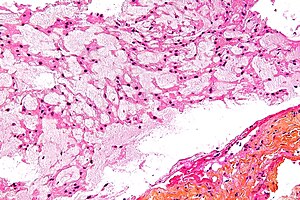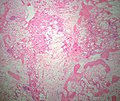Chordoma
Jump to navigation
Jump to search
The printable version is no longer supported and may have rendering errors. Please update your browser bookmarks and please use the default browser print function instead.
| Chordoma | |
|---|---|
| Diagnosis in short | |
 Chordoma. HPS stain. | |
|
| |
| LM | physaliphorous cells (also bubble cells) - very large clear bubble with a sharp border, bubble does not compress nucleus; islands of cells surrounded by fibrous tissue; myxoid background |
| LM DDx | chondrosarcoma, myxoid lesions, parachordoma, chordoid lesions (e.g. chordoid glioma, chordoid meningioma), metastasis (e.g. clear cell renal cell carcinoma) |
| IHC | S-100 +ve, AE1/AE3 +ve, Brachyury +ve, EMA +ve |
| Gross | myxoid |
| Site | sacrum or clivus |
|
| |
| Prevalence | uncommon |
Chordoma is an uncommon tumour in neuropathology.
General
- Location: usually sacrum or clivus.
- It is a malignant bone tumour (1-4% of all primary bone tumors).
- Usually after age 30.
Classification
- Chordoma, NOS (ICD-O: 9370/3).
- Chondroid chordoma (ICD-O: 9371/3).
- Dedifferentiated chordoma (ICD-O: 9372/3).
Gross
- Soft, gelatinous, lobulated.[1]
DDx:
- Bony metastasis (mucinous carcinoma) - typically multifocal.
Image:
Microscopic
Features:[2]
- Architecture: islands of cells surrounded by fibrous tissue.
- Also described as "lobulated" architecture; may not be apparent.
- Myxoid background - grey extracellular material, variable amount present.
- Mixed cell population:
- Abundant eosinophilic cytoplasm.
- Physaliphorous cells or bubble cells - key feature.
- Have a very large clear bubble with a sharp border; bubble does not compress nucleus - nucleus may be in bubble.
DDx:
- Chondrosarcoma - negative for EMA and cytokeratins. Beware of 'chondroid' chordoma.
- Myxoid lesions.
- Myxopapillary ependymoma.
- Myxoid liposarcoma - negative for EMA and cytokeratins.
- Chordoid lesions.
- Chordoid meningioma.
- Chordoid glioma[3] - location, location, location.
- Large notochordal rest - only evidence of destructive growth can identify a chordoma.
- Metastasis.
- Metastatic signet ring cell carcinoma - negative for S100 and brachyury, clinical history (important).
- Metastatic clear cell renal cell carcinoma - negative for S100 and brachyury, clinical history (important).
- Parachordoma - extremely rare.
Images
Case 1
Case 2
Case 3
www
- Chordoma (upmc.edu).
- Chordoma - sacrum - several images (upmc.edu).
- Chordoma - additional case with several images (upmc.edu).
IHC
- S-100 +ve - important.
- AE1/AE3 +ve - important.
- Brachyury +ve - key stain.
- EMA +ve.
- PAX8 -ve (1 +ve (weak) of 12.[8]).
- Other keratins:[9]
Classic chordoma panel:[10]
- EMA, AE1/AE3, CAM5.2, vimentin, S-100.
Key points:
- Brachyury is not a commonly stocked antibody.
- Chordoma will be S100 and epithelial marker positive.
- Many other items in the DDx will be either S100 or epithelial marker positive.
See also
References
- ↑ URL: http://www.histopathology-india.net/Chordoma.htm. Accessed on: 12 April 2012.
- ↑ Tadrous, Paul.J. Diagnostic Criteria Handbook in Histopathology: A Surgical Pathology Vade Mecum (1st ed.). Wiley. pp. 184. ISBN 978-0470519035.
- ↑ Zarghouni, M.; Vandergriff, C.; Layton, KF.; McGowan, JB.; Coimbra, C.; Bhakti, A.; Opatowsky, MJ. (Jul 2012). "Chordoid glioma of the third ventricle.". Proc (Bayl Univ Med Cent) 25 (3): 285-6. PMID 22754136.
- ↑ URL: http://path.upmc.edu/cases/case312/micro.html. Accessed on: 14 January 2012.
- ↑ Coindre, JM.; Rivel, J.; Trojani, M.; De Mascarel, I.; De Mascarel, A. (Sep 1986). "Immunohistological study in chordomas.". J Pathol 150 (1): 61-3. doi:10.1002/path.1711500110. PMID 2431128.
- ↑ Online 'Mendelian Inheritance in Man' (OMIM) 601397
- ↑ URL: http://www.jstor.org/pss/86845. Accessed on: 18 May 2010.
- ↑ Sangoi, AR.; Karamchandani, J.; Lane, B.; Higgins, JP.; Rouse, RV.; Brooks, JD.; McKenney, JK. (Mar 2011). "Specificity of brachyury in the distinction of chordoma from clear cell renal cell carcinoma and germ cell tumors: a study of 305 cases.". Mod Pathol 24 (3): 425-9. doi:10.1038/modpathol.2010.196. PMID 21102418.
- ↑ Naka, T.; Iwamoto, Y.; Shinohara, N.; Chuman, H.; Fukui, M.; Tsuneyoshi, M. (Jun 1997). "Cytokeratin subtyping in chordomas and the fetal notochord: an immunohistochemical analysis of aberrant expression.". Mod Pathol 10 (6): 545-51. PMID 9195570.
- ↑ Shen, J.; Shi, Q.; Lu, J.; Wang, DL.; Zou, TM.; Yang, HL.; Zhu, GQ. (Dec 2013). "Histological study of chordoma origin from fetal notochordal cell rests.". Spine (Phila Pa 1976) 38 (25): 2165-70. doi:10.1097/BRS.0000000000000010. PMID 24296480.













